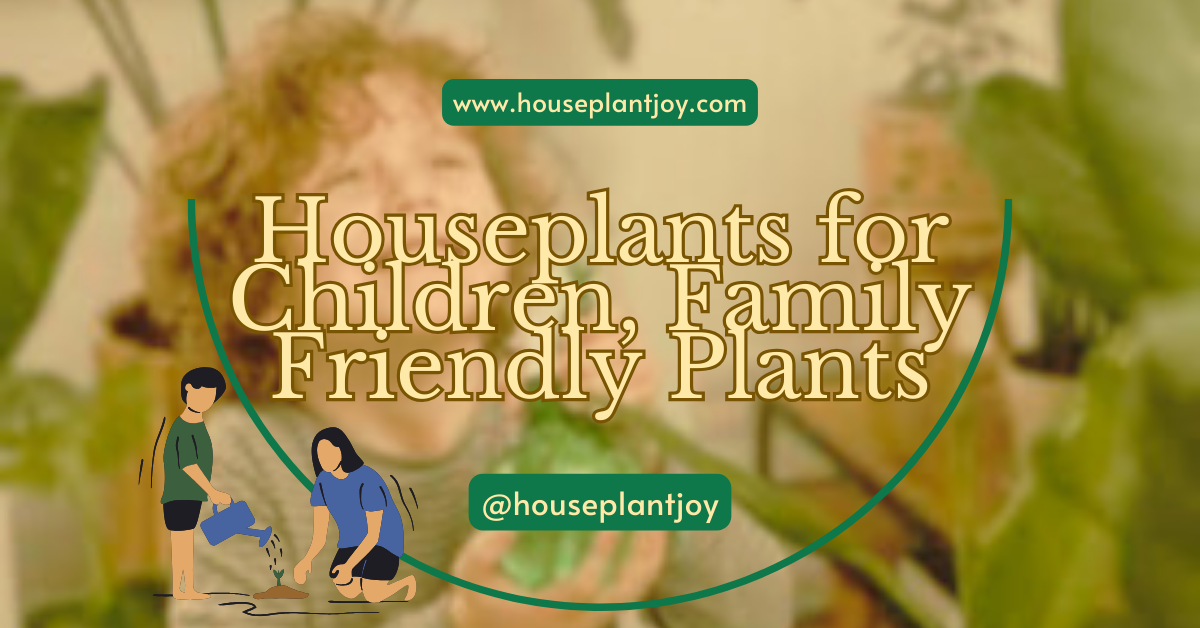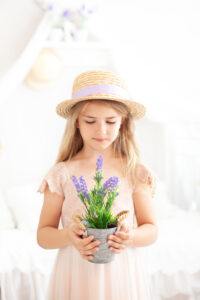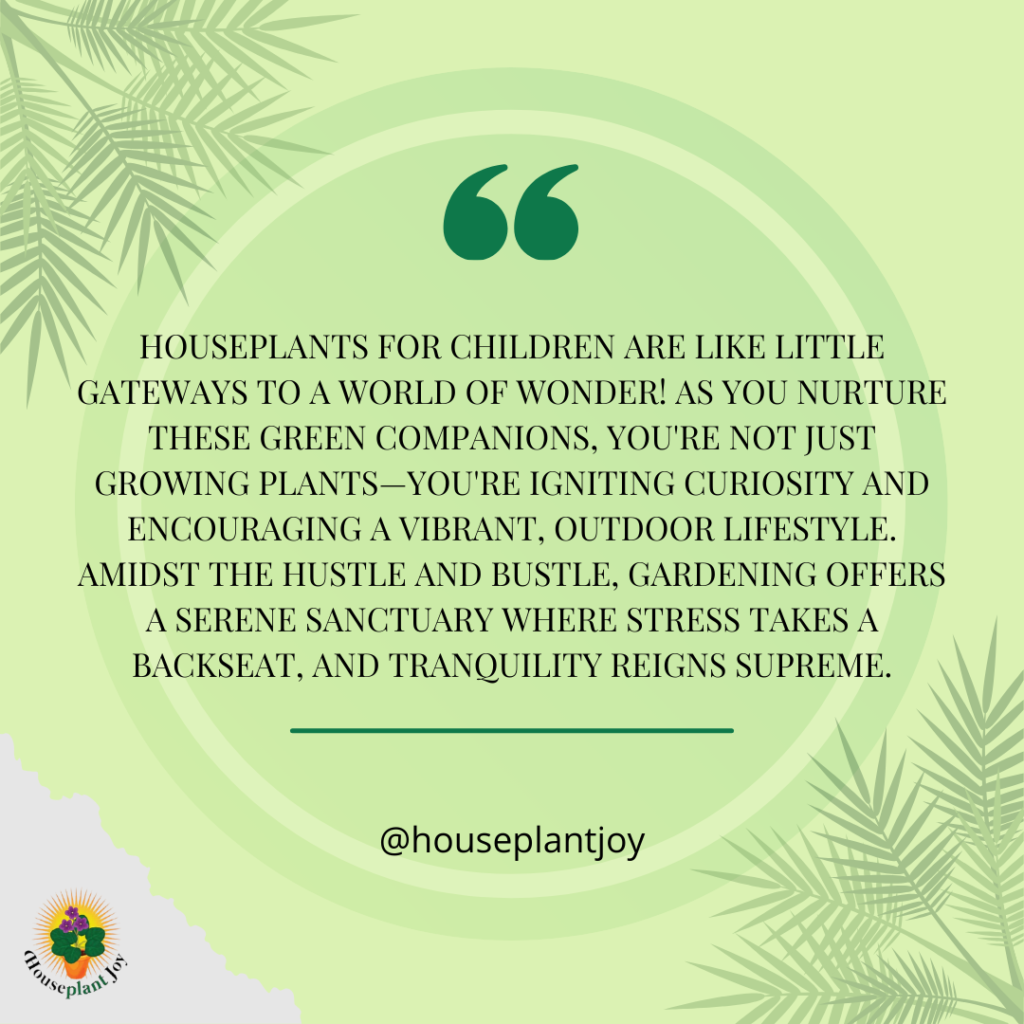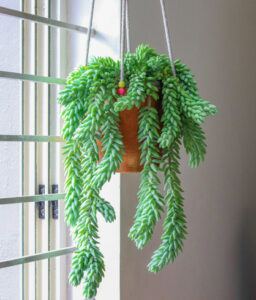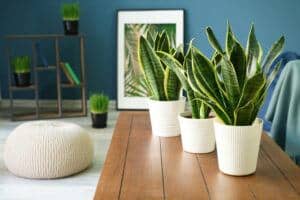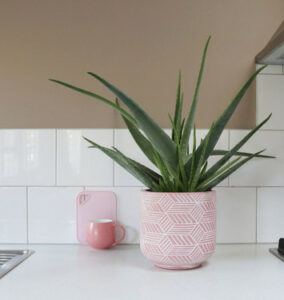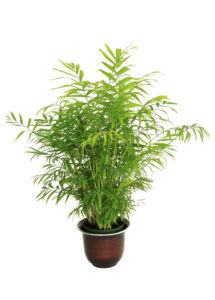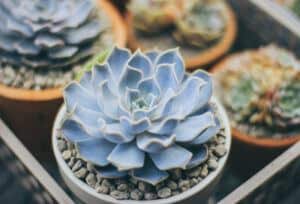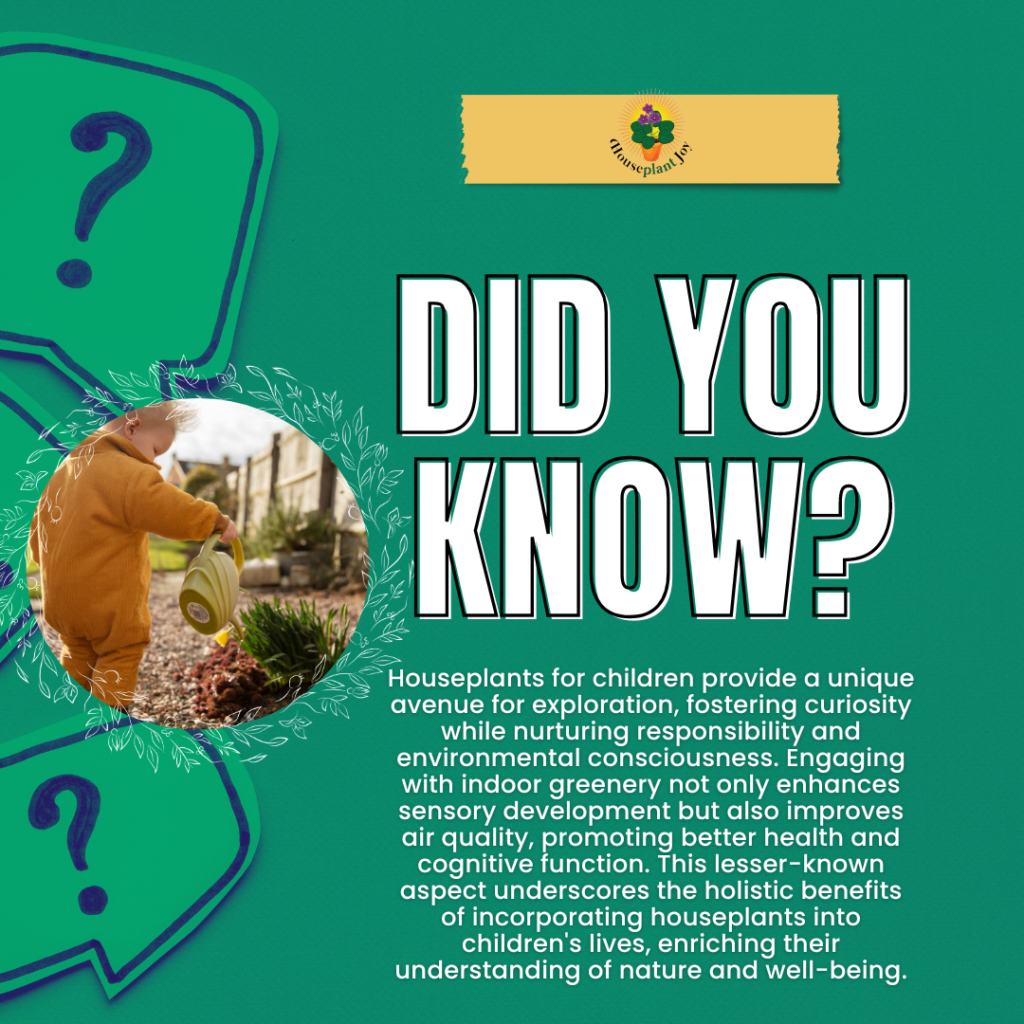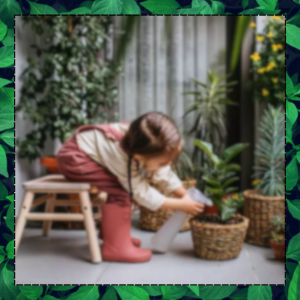HousePlantJoy is supported by our audience. When you purchase through one of our links, we may earn a small affiliate commission. As an Amazon Associate I earn from qualifying purchases. Your cost is not affected.
==================
Creating a family-friendly environment is a paramount goal for parents, and fostering positive habits in children is key to achieving this.
One impactful way to instill a love for nature in the younger generation is through the introduction of houseplants for children. These green companions not only contribute to a visually appealing home but also offer numerous health and psychological benefits.
In this guide, we’ll explore the importance of an eco-conscious mindset in children, the benefits of maintaining family-friendly plants, and factors to consider when selecting houseplants for children.
Discover a curated list of family-friendly plants that not only enhance the aesthetic appeal of your home but also provide a safe and enriching environment for your little ones. Join us on this journey of cultivating a love for nature in your children through the vibrant world of houseplants.
Houseplants for Children, Family Friendly Plants
Creating a family-friendly environment for children involves fostering positive habits, and instilling a love for plants in the younger generation is an effective way to achieve this goal. To cultivate this appreciation, it’s essential to maintain family-friendly plants, with a special focus on houseplants for children.
Encouraging an eco-conscious mindset in children is crucial, as it sets the foundation for them to become environmentally responsible individuals. Given the increasing global population, nurturing an environmentally friendly future generation becomes imperative.
Introducing children to gardening through a diverse array of houseplants, especially those designed for children, is an impressive approach. Regularly adding new plant varieties enhances the experience. The benefits of maintaining houseplants extend beyond mere aesthetics. These plants not only acquaint young children with ecological companions but also offer significant health and psychological advantages. They contribute to air purification and absorb carbon dioxide, providing a semblance of outdoor benefits even in urban settings.
While the benefits of keeping houseplants are numerous, it’s important to ensure that the chosen plants are specifically child-friendly. Before selecting specific plants for your home, consider certain factors to create a safe and suitable environment for children, emphasizing houseplants for children in particular.
Factors to Consider
Houseplants for Children are Family Friendly Plants
When you have children at home, it’s crucial to select plants with their safety in mind. Specifically crafted for a family-friendly environment, houseplants for children offer a balance between aesthetics and well-being. Choosing plants tailored to the needs of your young ones ensures a harmonious blend of nature in your home while prioritizing their safety and development.
Poisonous Plants
When it comes to houseplants for children, it’s crucial to consider their safety, especially since young kids tend to explore by putting things in their mouths. Parents need to be vigilant about the types of plants their kids are exposed to, as young children have a low toxicity threshold. Accidental ingestion of any plant part can be more harmful to them than to adults. Therefore, it’s advisable to avoid plants with potential toxicity, such as English Ivy, Peace lilies, Devil’s Ivy, and others.
Alternatively, if you still wish to include potentially toxic plants in your home, consider placing them in hanging planters positioned out of the child’s reach. This precautionary measure can create a safe distance while allowing you to enjoy these plants. However, it’s essential to keep such plants trimmed, preventing them from growing over the sides of the planter and becoming accessible to curious hands. Balancing the aesthetic appeal of houseplants with the safety of young children involves strategic placement and thoughtful consideration of plant choices.
Thorny Plants
In the realm of selecting houseplants for children, it’s crucial to navigate potential pitfalls, particularly those presented by plants adorned with prickly leaves or thorns, such as the resilient desert cactus. The inherent danger lies in the increased risk of injury for curious young ones who may inadvertently come into contact with these botanical defenders. While it’s true that children tend to develop an awareness of avoiding such prickly elements as they mature, a precautionary stance during the initial stages is advisable.
To address this concern creatively, one might choose to either sidestep plants with prickly attributes altogether or elevate them to higher shelves, beyond the inquisitive reach of the child. This proactive strategy not only ensures a secure environment for your little explorer but also allows you to cultivate a diverse and intriguing collection of plants in your home. Achieving a harmonious balance between the allure of aesthetically pleasing houseplants and the safety of inquisitive young minds involves an artful placement strategy and a meticulous consideration of potential botanical hazards.
Family Friendly Plants To Consider
When seeking children-friendly plants, consider non-toxic varieties to mitigate accidental ingestions, mindful placement of plants with prickly features, and opt for indoor varieties that thrive with minimal maintenance. This thoughtful approach ensures a safe and sustainable botanical environment for both parents and children in the home.
Bright and Vibrant Plants
Elevate your family’s botanical experience by opting for plants adorned with lively and vibrant-hued flowers. The allure of bright colors not only captivates the attention of children but also promises to keep them genuinely engaged. Choosing plants that ignite curiosity is paramount; a lackluster plant devoid of intrigue might undermine the very essence of incorporating houseplants for children. Selecting flora that sparks fascination ensures that the journey into the world of plants becomes a captivating and enriching endeavor for the entire family.
Low-Maintenance Plants
Acknowledging the full-time commitment that comes with parenthood, it’s prudent to avoid adding the burden of high-maintenance plants to the mix. Opting for low-maintenance botanical companions capable of enduring extended periods indoors without frequent watering or fertilizing becomes a practical choice.
While children typically adore their leafy friends, occasional lapses in maintenance are inevitable. Choosing resilient plants that can withstand such lapses ensures that both the plants and the children’s hearts remain unbroken, fostering a nurturing and stress-free environment within the home.
Plants With Lightweight Pots
When selecting plants for your home, prioritize those that thrive in lightweight pots. Bulky and hard clay pots pose challenges in a household with children, and it’s advisable to steer clear of them.
However, for larger plants situated on the floor or in proximity to high-traffic areas, opting for a sturdier, heavier pot becomes a strategic choice to prevent accidental tipping. Deliberate consideration of the plant’s size and placement is essential when making decisions about the type of pot or container, ensuring a harmonious balance between the plant’s needs and the safety of the surrounding environment.
Favorite Houseplants For Children
Highlighted below are several indoor plants that hold immense popularity among children of all ages. These engaging and enchanting botanical companions not only bring a touch of nature indoors but also captivate the imaginations of young minds, fostering a delightful connection with the world of plants.
Burro’s Tail
Meet this charming succulent, a green companion that effortlessly weaves its way into low-maintenance bliss, resilient against the occasional neglect it might encounter. Its aesthetic appeal goes beyond the ordinary – hanging delicately in a basket, adorned with vibrant pink hues that are sure to capture the hearts of children.
However, a word of care dances through the leaves: this succulent prefers a measured approach to watering, as excessive moisture can be detrimental. So, in this verdant friendship, it’s essential to whisper to the children the importance of understanding and tending to each plant’s unique needs, cultivating a bond that blossoms with mindful care.
African Violets
Embark on a botanical journey with African violets, where their need for frequent watering is harmoniously balanced by their captivating aesthetic allure. These delightful plants, adorned with vibrant hues, gracefully occupy limited space, thriving in the coziness of small plastic pots. Beyond their visual appeal, African violets have secured a special place in hearts for their rapid growth and short generation times, making them beloved companions in the realm of indoor gardening.
For the green enthusiasts eager to explore the art of plant propagation, the African Violet emerges as a splendid choice. Effortlessly rooting from cuttings and displaying a penchant for swift growth, these plants weave a narrative of propagation that unfolds with remarkable ease. So, in the dance of nurturing these botanical gems, one not only tends to their immediate needs but also becomes part of a captivating story of growth and renewal.
Snake Plant
Discover the ubiquitous presence of snake plants, readily available at nearby nurseries, bringing a touch of greenery to your indoor space. This resilient companion not only enhances your living environment but also alleviates the need for potentially harmful pesticides or insecticides, a crucial consideration, especially in households with children. In the canvas of indoor gardening, the snake plant paints a picture of accessibility, warding off pests while creating a secure and enchanting atmosphere for plant enthusiasts and their curious little companions.
Aloe Vera
Embrace the global fame of Aloe Vera as an indoor plant, renowned among savvy housewives for its multifaceted role in daily skincare routines. Yet, this versatile plant holds the potential to become a cherished favorite among your children as well. Nestled among the ranks of low-maintenance plants, Aloe Vera falls gracefully into the succulent category, promising a hassle-free addition to your green family. Beyond its practical uses, Aloe Vera weaves a tale of simplicity and appeal, beckoning both skincare enthusiasts and young plant enthusiasts into its verdant embrace.
Bamboo Palm
Explore the world of bamboo palms, a remarkable choice, particularly if you aim to impart botanical knowledge to your children. This plant serves as an engaging educational tool, showcasing all the essential parts of a typical plant – from the stem to leaves, flowers, and roots. It transforms into an interactive learning experience, providing your child with a firsthand exploration of the intricate components that make up a plant. However, be mindful that this verdant tutor requires a bit more space compared to its counterparts and thrives best in a well-lit environment with consistent exposure to sunlight, ensuring a flourishing educational journey for both plant and learner.
Echeveria
Among the illustrious array of plants on this list, Echeveria stands out as a true floral gem. Its exquisite violet-colored flowers unfurl in the shape of delicate bowls, captivating the beholder and claiming its place as an absolute eye-catcher. Beyond its aesthetic allure, these succulents demand minimal care, offering a delightful harmony of interesting textures and colors. Echeveria, with its mesmerizing blooms and undemanding nature, not only elevates the visual appeal of your space but also provides a sensorial journey through the diverse and captivating world of plant aesthetics.
Jade Plant
Delve into the world of Jades, symbolic not just of wealth but also considered harbingers of good luck in certain cultures! Compact and easily accommodated in small ceramic pots, Jades are especially well-suited for kids. While every plant requires a modicum of care, these resilient succulents demand only minimal attention, sparing you from the need to tend to them seven days a week. Jades possess the remarkable quality of self-sufficiency, continuing to grow and thrive with little intervention. It is for these reasons that we deem the Jade Plant as one of the finest family-friendly additions to your botanical ensemble.
The plants showcased above extend beyond mere aesthetics; they are inherently children-friendly and serve as valuable allies in instilling a love for nature in your little ones from an early age. Recognizing the importance of this opportune time, a modest investment in these green companions goes a long way in fostering the personal growth and grooming of a child, creating a lasting impact on their journey of discovery and connection with the natural world.
Educational Benefits of Houseplants for Children
Introducing houseplants for children goes beyond enhancing your home’s aesthetic appeal; it also presents a myriad of educational advantages. These green companions offer a hands-on opportunity for kids to learn about plant life cycles, photosynthesis, and the fundamental components that make up a typical plant.
Exploring the Green Classroom
Houseplants become interactive learning tools, turning your home into a green classroom. Children can actively engage with plants like the Bamboo Palm, gaining firsthand knowledge of stems, leaves, flowers, and roots. This immersive experience fosters a deeper understanding of the natural world, complementing traditional education with a tangible, hands-on approach.
Nurturing Curiosity and Responsibility
As children care for their botanical friends, they develop a sense of responsibility and nurturing. This hands-on care not only instills valuable life skills but also encourages curiosity about the environment. By repeating the main keyword “houseplants for children,” we reinforce the idea that these plants are specifically tailored to benefit the younger generation.
Incorporating educational elements into your home through houseplants is a simple yet effective way to create a stimulating and enriching environment for your children. Embrace the educational journey that houseplants offer, cultivating a love for learning through the vibrant world of nature.
Cultivating a Greener Tomorrow
In the pursuit of creating a family-friendly haven, the introduction of houseplants for children emerges as a powerful catalyst for positive habits and eco-conscious mindsets. We’ve explored the significance of fostering a love for nature in the younger generation, emphasizing the delicate balance between aesthetics and well-being.
From steering clear of potentially harmful plants to embracing educational benefits, our guide has provided insights into curating a safe and enriching environment for your little ones. Houseplants for children, carefully chosen and strategically placed, not only contribute to air purification but also serve as engaging educational tools.
Nurturing Nature’s Allies
As we conclude, consider the enduring impact that these green companions can have on your children’s growth. Beyond the visual charm they bring, houseplants become allies in nurturing curiosity, responsibility, and a lifelong love for the environment.
Take the Next Step
Are you ready to embark on this green journey with your family? Explore our recommended family-friendly plants, incorporate the educational benefits, and witness the transformative power of houseplants for children. Cultivate a greener tomorrow today!
Discover Your Perfect Houseplant for Children Now!
Frequently Asked Questions
Are all houseplants suitable for children?
No, not all houseplants are suitable for children. It’s crucial to choose plants that are non-toxic and pose no harm if accidentally ingested. Additionally, considering factors like thorns or prickly leaves is important to ensure a safe environment for curious little ones.
How can I incorporate educational aspects into the houseplant experience for my children?
To enhance the educational benefits of houseplants, engage your children in activities such as observing plant life cycles, discussing photosynthesis, and exploring the essential parts of a plant. Choose interactive plants like the Bamboo Palm, turning your home into a green classroom for hands-on learning.
What are some low-maintenance houseplants suitable for families with busy schedules?
Families with busy schedules can opt for low-maintenance houseplants like Snake Plants, Aloe Vera, or African Violets. These resilient plants thrive with minimal care, making them ideal companions for parents who may not have the time for frequent watering or extensive maintenance.
Plantify Your Feed with Houseplant Joy! ?✨
Ready for a green revolution? ? Follow us on Facebook, Insta, Pinterest, Twitter, and catch our leafy moves on TikTok. ?? Immerse in the joy of houseplants, discover awesome reviews, and vibe with a community as plant-obsessed as you are! ?✨ Let’s grow together — Houseplant Joy style! ?? #PlantJoyfully ?
Additional Good Reads

